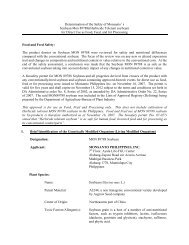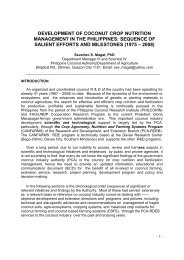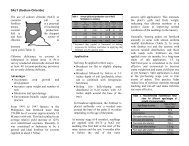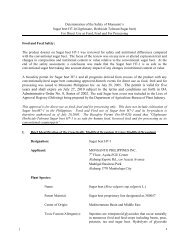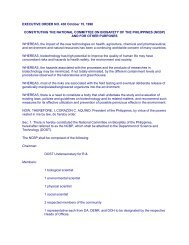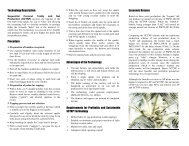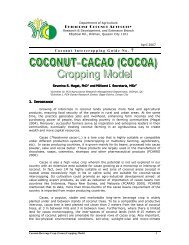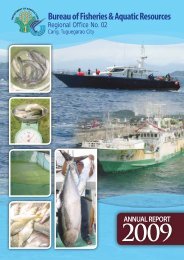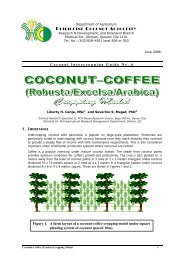Department of Agriculture - Philippine Coconut Authority ...
Department of Agriculture - Philippine Coconut Authority ...
Department of Agriculture - Philippine Coconut Authority ...
- No tags were found...
You also want an ePaper? Increase the reach of your titles
YUMPU automatically turns print PDFs into web optimized ePapers that Google loves.
out the juice removes much <strong>of</strong> the toxic compounds. Heat used to dry theresulting flour removes the remaining compounds. The resulting flour, calledfar<strong>of</strong>a is very bland, rather like corn meal and flour. The flour can be mixedwith water and the dough cooked on a large griddle to make a large cassavaflat-breads).4.2.1.2 Sweet potato1) Land preparation – To have good root yield <strong>of</strong> the crop, plow and harrow thesoil twice until soil is loose and friable. Form ridges or furrows <strong>of</strong> about 30-40cm high by using carabao-drawn mold-board plow or tractor-drawn moldboard plow or tractor-drawn disc plow with a distance <strong>of</strong> about 75-100 cmsbetween ridges (http://www.da.gov.ph.farming tips [from BPI Sweet PotatoCommodity Pr<strong>of</strong>ile –DA-Eastern Visayas Integrated Agric .Research Center]) ).2) Planting materials and variety – Use sprouts from roots <strong>of</strong> previous crop orvine tip cuttings from healthy plants 25 cm long. However, for economicreasons, tip or terminal vine cuttings immediately or you can store them inshaded place but they should be planted within 2 days from the time the theyare cut).The selection <strong>of</strong> the proper variety to grow is dependent on the purpose forwhich it is grown. The following 14 varieties are recommended by the Phil.Seed Board: UPL SP1, UPL SP 3, UPL SP5, BPI SP 1, BPI SP 2, PSB SB -13,14,15,16,17, UPL SP, VSP -5,6,7 (http://www.da.gov.ph.farming tips[from BPI Sweet Potato Commodity Pr<strong>of</strong>ile –DA-Eastern Visayas IntegratedAgric .Research Center]) ).3) Planting – plant vine cuttings diagonally on top <strong>of</strong> ridges during the rainyseason to prevent the crop from being soaked under water, or in the furrowsduring dry season so that moisture reserve in the soil can be utilized by thecrop. Expose 2-3 leaves at the tip at a distance <strong>of</strong> 25 cms between hills. Onecutting per hill is equivalent to 33,000 hills per ha).4) Fertilization –In the absence <strong>of</strong> soil analysis <strong>of</strong> the area, follow the generalfertilizer recommendation for: poor soil, use 4-6 bags complete (14-14-14)fertilizer /ha, moderate fertile soil – use 4 bags complete fertilizer/ha, forfertile soil, fertilization is not advisable. Apply fertilizer at planting time at 8-10 cms from the base <strong>of</strong> the plant or broadcast in the furrows and coversubsequently with soil. The use <strong>of</strong> compost or organic fertilizer at 3 tons/ha ishighly recommended).5) Cultivation and weeding – If weeds are abundant, shallow cultivation is done10-12 days after planting. Hilling-up cultivation is done at 25-30 days afterplanting. This is to provide enough soil to cover the developing roots andthus, minimize the entry <strong>of</strong> weevils that may attack the growing roots).6) Pest and disease management – Foliar spraying <strong>of</strong> fevinthrothion at 0.5% one(1) month after planting and twice at 50 days and 70 days after planting(DAP).7) Harvesting – Most <strong>of</strong> the recommended varieties are ready for harvest 110-130 DAP. Harvesting can be determined by root sampling and if desired sizehas been attained, harvesting can be done anytime. Before harvesting, cutand roll the vines like a mat, fork, hoe or pass a plow below the ridges, then<strong>Coconut</strong>-Root Crops Cropping Model 10



